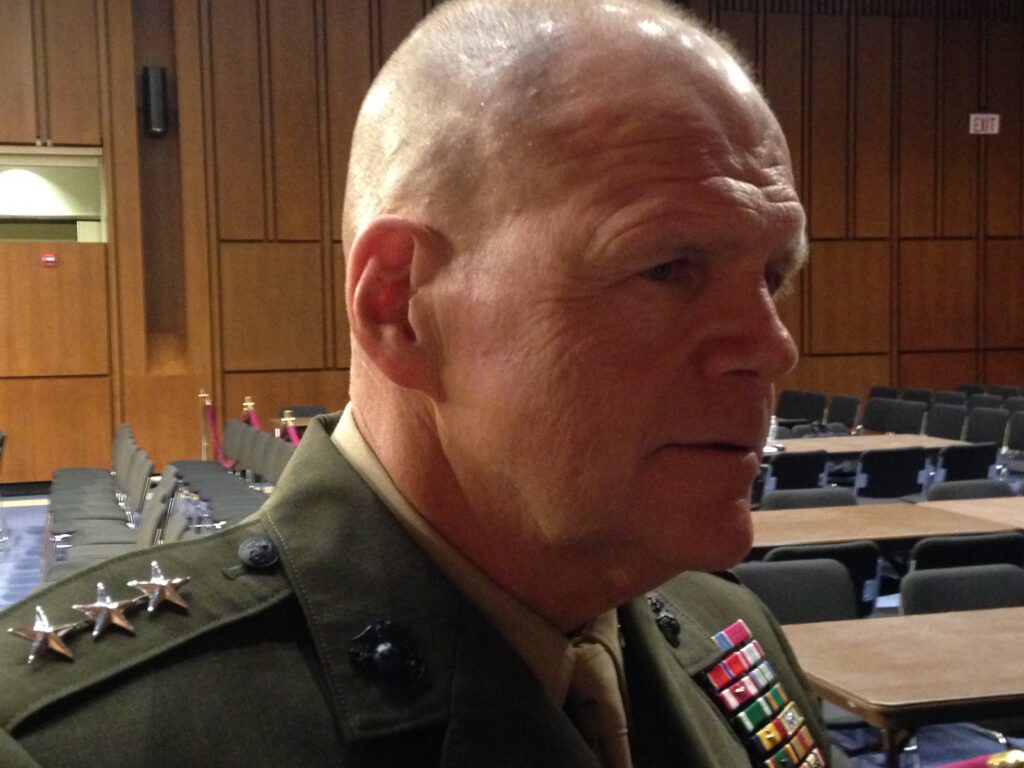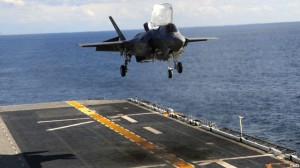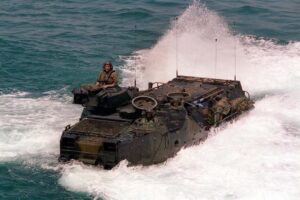
Lt. enen. Robert Neller after an arduous confirmation hearing.
CAPITOL HILL: UPDATE BEGINS The administration’s nominee for Marine Corps Commandant, Lt. Gen. Bob Neller, set off a firestorm from Sen. John McCain this morning. After two hours of an otherwise congenial confirmation hearing, the Senate Armed Services Committee chairman erupted over Neller’s description of the current administration strategy against the Islamic State. That strategy relies on airpower and advisors while keeping US forces far from front line roles.
“Well, general, before we close,” McCain said after the last committee member has had a turn to pose questions, “when you say we’re doing what we need to do in Iraq….I don’t know where you’ve been. Obviously ISIS is winning in Iraq.”

John McCain
And don’t give “some scholastic answer” to the committee’s questions, McCain fumed, having minutes earlier directed Neller to answer his protege Lindsey Graham’s questions more directly. “You know full well as I do, forward air controllers make the difference!” McCain said. “Without American assistance, including airpower, including forward air controllers on the ground, we’re going to see this stalemate.”
“Maybe you can tell me what we’re doing that will win against ISIS,” the senator said sarcastically. “Can you tell me that?”
“Senator,” Neller replied with the caution that had characterized his responses throughout the hearing, “what we’re doing, I believe, is providing advisor teams and support…”
McCain cut him off: “And that’s succeeding?”
“It stemmed the tide [against] ISIS, but it is not removing them from Iraq,” Neller said.
“So you believe that ISIS is losing?”
“No sir, I do not.”
“Do you believe they’re winning?
“No, sir,” said Neller. “I don’t believe they’re winning either, I believe they’re at a stalemate.”
It’s a stalemate where the enemy controls much of Iraq and “the only people fighting against them” are Iranian-backed Shia militias, McCain countered (with some injustice to the Iraqi military and Sunni militias). “I don’t think we are quote ‘doing what we need to do,’ general,” the Senator said. “I’m going to give you some written questions. I’m very disappointed in a number of your answers.”
“We lost too many good Marines in the battle of Fallujah and Ramadi” — cities now held by ISIS — fumed McCain. “Sen. Graham and I were over there and one of my sons fought there….For us to say we’re doing what we need do it, I think, frankly, is not keeping with the appreciation that we should have for the sacrifice that those brave young people have made.”
The committee’s top Democrat, Sen. Jack Reed, hastily stepped in: “I don’t think anyone understands the sacrifices the Marines made in Iraq better than Gen. Neller,” who served there himself.
(In fact, Neller wears a wristband bearing the name of a Marine who died — more on that below).
“I answered the questions [to] what I thought, [was to] the best of my ability,” Neller told reporters after the hearing. “We’ll take the questions for the record that we get from the senator and we’ll provide the best answers we can.”
Neller had been cautious throughout the hearing — more so than prospective Army Chief of Staff Gen. Mark Milley, whose untroubled confirmation hearing was Tuesday. In the first minutes of questioning this morning, McCain pressed Neller on one of the senator’s favorite proposals, giving service chiefs more authority over the troubled acquisition process. Milley had responded without hesitation that they needed more authority — a position shared by the outgoing Army Chief of Staff, Gen. Ray Odierno. Neller dodged the question so nimbly that the dogged McCain gave up. “I’d like to believe if confirmed I’d provide value added,” was as emphatic as the Marine general got.
There was a similar contrast between the two generals on arming Ukraine. Milley unhesitatingly endorsed providing “lethal defensive equipment.” Neller declined to give a recommendation, offering only the observation that “it is my military opinion that, if we provided additional weapons to the Ukranians, they would be more capable of defending their territory.”
Call it cautious, call it thoughtful, or call it evasive, Neller’s style of answering questions clashed most dramatically with the senators’ style of asking them when it came the turn of McCain’s protege Lindsey Graham, a former military prosecutor and current presidential candidate. Graham launched into his standard barrage of leading questions intended to elicit quick yes-or-no answers. Neller didn’t cooperate.
Consider this exchange on the Chattanooga shootings:
Graham: “If the recruiters had been armed, do you think things would have been different?”

Sen. Lindsey Graham
Neller: [long pause] “Senator, I don’t know.”
Or this exchange on the danger of Iran:
Graham: “Do you believe the Ayatollah really means it when he says ‘Death to America’ and ‘Death to Israel’?”
Neller: [long pause] “Senator, I have never spoken to the Ayatollah to ask him.”
Eventually McCain felt compelled to jump in. “General, you’re not answering the senators’ questions,” McCain said. “Answer the question: Do you believe [the last proposition Graham just put forward] or not?”
Just two minutes later, McCain began his grilling of Neller over Iraq.

F-35B
Modernization
One area where Neller was emphatic: the F-35B. The Marine Corps variant of the Joint Strike Fighter is on the verge of Initial Operational Capability (IOC). The F-35B has done well in recent tests, Neller said, and the final report is with the outgoing Commandant, Gen. Joseph Dunford, for review. “Our plan was to declare IOC with them this month. That’s still their plan.” Gen. Dunford will make the final recommendation on IOC “soon,” Neller said.
But the F-35B is hardly the Marines’ only modernization hurdle. It was modernization concerns that dominated much of Neller’s carefully prepared written submission to the Senate. UPDATE ENDS
Being battle-ready is the Marine Corps’ No. 1 priority — but they can’t stay ready unless they replace a lot of aging equipment, from jets to helicopters to amtracs, Neller writes. But that takes money the Marines don’t have, at a time when they’re cannibalizing other priorities to sustain near-term readiness.
“The real key to…recovering readiness is in recapfitalization,” Lt. Gen. Robert Neller says in written answers provided to the Senate Armed Services Committee in advance of today’s hearing. Breaking Defense obtained a copy. “If we return to the sequestration-level cuts in Fiscal Year 2016, we will face serious risks to the modernization plans we currently have…. which could lead to reduced readiness rates.”
Near-term readiness and long-term modernization are different budget accounts and normally considered in competition: a dollar more for one means a dollar less for the other. But Neller argues that “every dollar decremented” from modernization hurts readiness as well.
Why? Throwing more money into readiness accounts hits diminishing returns when the equipment you’re trying to keep ready is wearing out. At some point you’ve got to just replace it.

Marine Corps AV-8B Harrier
Most expensively, that means buying F-35B jump jets to replace 1980s-vintage Harriers and Hornets. “Right now, across the USMC, 19-20% of my aviation assets that are supposed to be on the flight line (not in scheduled depot maintenance) aren’t able to fly,” Neller writes. “We are not buying enough airplanes. Our legacy airframes are aging and have been supporting combat operations for 15 straight years. Continuing to repair and modernize those aircraft will only get us so far and we are beyond the point now where we need to recapitalize the fleet.”
The Marines have the same problem with heavy-lift helicopters. “The CH-53E transition to the CH-53K is already slow,” said Neller. “We can’t sustain the 53E indefinitely and any future budgetary reductions to the CH-53K program will aggravate this situation.”
Then there’s the aging Amphibious Assault Vehicle, an ungainly hybrid of tank and boat that’s now in its forties. The AAV is getting protection and maintenance upgrades, because at least some are going to be around until the 2030s. But the Marines need a new, nimbler, and more numerous vehicle to carry them ashore and on inland. After two decades of trying and failing to making a “high water speed” amphibious vehicle — essentially a water-skiing tank — then-Commandant Gen. James Amos decided on a more modest wheeled vehicle.

The Marine Corps’s current Amphibious Assault Vehicle, the 1970s-vintage AAV-7.
The committee’s questions show a certain skepticism of this proposed Amphibious Combat Vehicle. Will the “four foreign designs” being evaluated have adequate mobility through the water? Well, Neller responds, there are actually five designs, only two of them non-US. Of those five, he says, “we are confident that at least two” — the number required for a second-phase competition later this year — “[will] achieve water mobility performance on par with or greater than our existing [AAV].”
All these modernization projects are under fiscal strain, however, and the Budget Control Act caps, aka sequester, might put them over the edge.
“I am very concerned that over the past few years, the Marine Corps’ ability to recapitalize and modernize for the future security environment has been undermined due to lower than optimal budgets,” Neller writes. “Sequestration impacts on key modernization programs will have catastrophic effects on achieving desired capabilities to defeat emerging threats and will place an unacceptable burden on legacy programs such as the AAV (40+ y[ears]/o[ld]) and the HMMWV [Humvee].”
UPDATED Equipment modernization isn’t an abstract issue for Neller, who pushed hard for anti-mine equipment in Iraq. He wears a bracelet engraved with the name of Corporal Eric Lueken, a young Marine killed in 2006 at the age of 23. “I never met him,” Neller told reporters. But Lueken died when his Humvee drove over a pressure-activated roadside bomb, just when Neller had been debating with his staff whether to install anti-mine rollers on vehicles to prevent exactly that kind of lethal incident.
“I read his casualty report…and I kind of thought to myself, ‘you’re supposed to be a general, your’e supposed to make decisions. You’re listening to all these guys telling you why this is a bad idea. You think it’s a good idea. So what are you hesitating for? What are you waiting for?'” Neller recalled. “So, next meeting we had, I heard it all again and I said no, we’re going to go build rollers. And we did.”
To this day, Neller said, “whenever I worry [or] start to doubt myself, … Lueken says, ‘be a general. Make a decision. Do something. Make it better.’ So that’s why I wear this.”
Connecticut lawmakers to grill Army, Lockheed about job cuts at Sikorsky helicopter unit
“The Connecticut delegation has questions about why, with that [FY24] appropriation in hand, this happened,” said Rep. Joe Courtney, D-Conn.


























